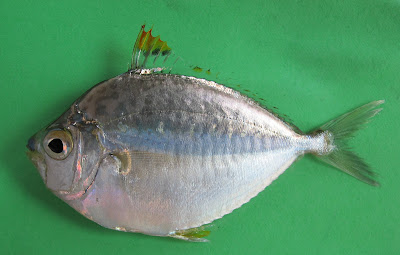Light-emitting organs have evolved in many different species of marine fish. For the greater part, they are associated with inhabitants of the deep sea, the twilight and midnight zones beyond the reach of celestial light. Light production by species found in shallow waters is much less common. Nevertheless, one particularly notable radiation of near-surface glowers is the ponyfishes of the family Leiognathidae.
Leiognathus equulus, copyright Sahat Ratmuangkhwang.
Ponyfishes are small, mostly silvery fishes found in coastal and brackish waters in tropical regions of the Indo-West Pacific. The largest ponyfishes grow to about 25 cm in length but most species are much smaller (Woodland
et al. 2002). They live in large schools that forage near the surface at night, descending close to the bottom sediment during the day. Why these animals are referred to as 'ponyfishes', I have no idea (perhaps the head is meant to look a bit pony-like?) An alternative vernacular name of 'slipmouth' makes a lot more sense as these fish have highly extensible jaws that can be used to snipe prey out of the water. A groove along the top of the skull allows for reception of a long, mobile premaxilla, supporting the mouth as an elongate tube when extended. Most ponyfishes are planktivores with simple, minute teeth in the jaw and the mouth extending horizontally. Species of the genus
Deveximentum have the mouth tilted obliquely at rest so that it stretches upwards when extended. Members of the genus
Gazza are piscivores when mature, feeding on other fish, and possess a pair of large caniniform teeth in each of the upper and lower jaws to hold their prey (James 1975).
Ponyishes are also notable for their elaborate light-producing organs. In most bioluminescent fishes, the photophores sit on or close to the skin surface but in leiognathids it is an internal outgrowth of the gut. A cavity around the end of the oesophagus houses colonies of bioluminescent bacteria, usually the species
Photobacterium leiognathi. This light organ sits alongside or projects into the gas bladder which has a reflective internal coating. In many species, patches of scale-less, translucent skin allow the transmitted light to shine forth brightly. Muscular 'shutters' associated with the light organ allow the fish to control light transmission more directly (Woodland
et al. 2002).
Photopectoralis bindus, copyright D. G. R. Wiadnya.
In a review of ponyfish taxonomy by James (1975), no mention was made of the light-emitting organ or many of its associated structures (though reference was made to the absence of scales on certain parts of the body). With the exceptions of the distinctive genera
Gazza and
Deveximentum, ponyfishes were assigned to a broad genus
Leiognathus. Since then, variations in the structure of the light organ have been recognised as taxonomically significant, allowing the recognition of several genera divided between two subfamilies Leiognathinae and Gazzinae (Chakrabarty
et al. 2011). Leiognathinae is defined by plesiomorphic characters and is likely to be paraphyletic to Gazzinae (Sparks & Chakrabarty 2015).
Because of the nocturnal habits of ponyfish and the delicacy of the light-emitting structures, our understanding of how light production functions in Leiognathidae remains somewhat limited. In Leiognathinae and females of Gazzinae, the light organ is relatively small and the external body surface lacks translucent patches. For the most part, light is expressed in these individuals as a uniform ventral glow that probably functions as counter-illumination (the light from the venter prevents the fish from appearing as a silhouette against light from the water surface to predators swimming below). Alternatively, light may be flashed to warn school-mates of danger. In males of Gazzinae, conversely, the light organ is enlarged relative to females and associated with translucent 'windows'. The shape of the organ and the arrangement of the 'windows' is a primary factor in distinguishing genera. Rhythmic flashing of light has been observed in males of many gazzine species and is probably characteristic of the group as a whole. Woodland
et al. (2002) observed a school of several hundred
Eubleekeria splendens flashing their lights synchronously shortly after nightfall. The exact function of such displays is uncertain, whether in courtship displays, co-ordinating school movements, attracting prey or dissuading predators. The sexually dimorphic nature of the light organ system, together with its species-specific expression, might seem to favour the first of these options but it should be noted that they are not all mutually exclusive.
Despite their small size, ponyfishes are often significant food fish for people living in areas where they are found. Thanks to their schooling behaviour, they are often a major component of dredge catches. In the Philippines, they are used for making bagoong, a fermented fish paste. In other places, they may be cooked whole after cleaning. The glow, sadly, does not survive the process.
REFERENCES
Chakrabarty, P., M. P. Davis, W. L. Smith, R. Berquist, K. M. Gledhill, L. R. Frank & J. S. Sparks. 2011. Evolution of the light organ system in ponyfishes (Teleostei: Leiognathidae).
Journal of Morphology 272: 704–721.
James, P. S. B. R. 1975. A systematic review of the fishes of the family Leiognathidae.
J. Mar. Biol. Ass. India 17 (1): 138–172.
Sparks, J. S., & P. Chakrabarty. 2015. Description of a new genus of ponyfishes (Teleostei: Leiognathidae), with a review of the current generic-level composition of the family.
Zootaxa 3947 (2): 181–190.
Woodland, D. J., A. S. Cabanban, V. M. Taylor & R. J. Taylor. 2002. A synchronized rhythmic flashing light display by schooling
Leiognathus splendens (Leiognathidae: Perciformes).
Marine and Freshwater Research 53: 159–162.
source
http://coo.fieldofscience.com/2022/03/by-light-of-pony.html













